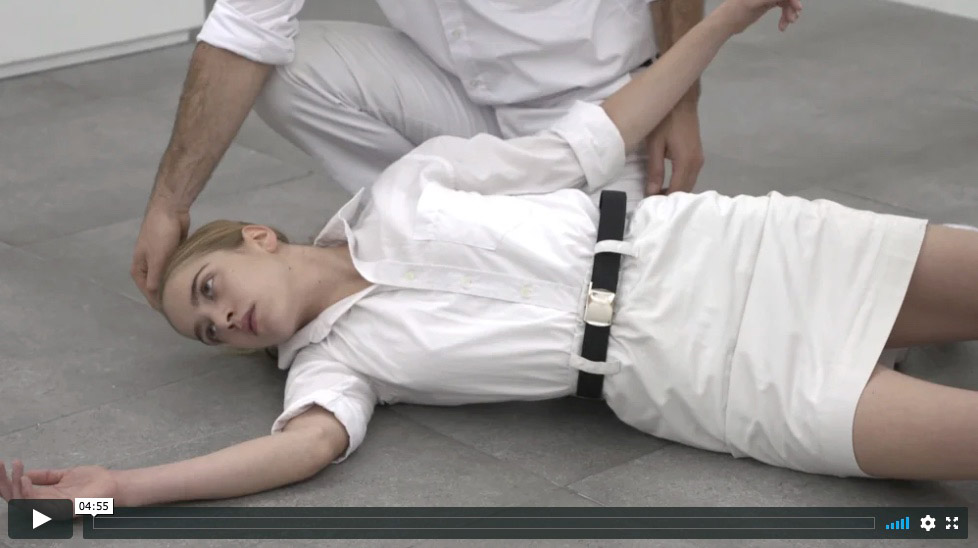JOURNAL
CHAPTER II: ETTORE SPALLETTI
Ettore Spalletti di Pappi Corsicato, 21’
“My most vivid memory as a child or perhaps I was already a teenager is an event that used to take place every year, the Acerbo Cup car race in those days, it was really a big event, people would line up all along the circuit which began near the sea wound through the hills and returned to the coast. Viewing this race was the first time I had a visual perception of the beauty of colour a few months or perhaps a few weeks before the race they would repave the roads and the asphalt was deep, tar-black then they would outline the curves of the road with bales of hay so there was this contrast of black tar, yellow hay and green hillsides, through the image of the race it was almost as if a picture was immersed in the hills which descended from Cappelle towards the sea.”
Ettore Spalletti
The Second Chapter presents Ettore Spalletti, the documentary directed by Pappi Corsicato and produced by Artecinema Produzione. Ettore Spalletti’s voice-over takes the viewer on a journey in Abruzzo through time. Slow. Like the tone of his voice as he tells another story at the same time – his private life that interesects with his work: in between his house and his studio, he used to say that his day was included in 4km, the km necessary to make those transfers, the ones he was making every single day. A double vision: in and out of the windows, his landscape was the one that goes from Appenini to the sea. It is a still, static and changing landscape. In telling as in life Spalletti uses a double registrer that refers to art history and its color, but also to the feeling of being part of his own landscape and its colors that surround us all the time. “A landscape that man wanted to destroy, attacking the hills, the mountains and everything that surrounds us.”
Crossing his private and public life Spalletti also transforms his bedroom at his mother’s house in an artwork. Keeping her hands crossed, she is framed like an ancient painting in a still space. He is the viewer of his memories.
Ettore Spalletti (Cappelle sul Tavo, Pescara, 1940 – 2019) developed a singular, solitary voice and a resultant body of work that exceeds any movement that circumscribes an artist to regional or ideological boundaries. Spalletti’s formal vocabulary has always melded and balanced painting and sculpture, form and color, interior and exterior space. Each work is the result of a meditative but rigorous process of applying a layer of color at the same time of each day, to capture a specific tone that recalls an hour, a season, and the weather. His work is included in many istitutions worlwide.
“Ero bambino, forse quasi ragazzo, e la cosa che ricordo di più era questo evento che succedeva ogni anno. Era la coppa Acerbo, una corsa automobilistica, e questo è stato un evento perché in quei giorni questo circuito che dal mare tornava al mare attraverso le colline si riempiva di gente. E per la prima volta visivamente ho sentito un cromatismo bellissimo dentro le immagini della corsa perché un mese prima o qualche settimana prima rifacevano l’asfalto, e allora questa striscia d’asfalto diventava di un nero profondo, di un nero catrame. E dopo disegnavano tutte queste curve con le balle di paglia, allora c’era questo nero del catrame, il giallo della paglia e il verde delle colline, era come un disegno che si immergeva attraverso l’immagine della corsa, dentro le colline che da Cappelle scendevano verso il mare.”
Ettore Spalletti
Il secondo capitolo presenta Ettore Spalletti, il documentario con la regia di Pappi Corsicato, prodotto da Artecinema Produzione.
La voce fuori campo di Ettore Spalletti accompagna lo spettatore in un viaggio nel tempo in Abruzzo. Lento. Come il timbro della sua voce mentre racconta di una storia parallela – la sua vita privata che si intreccia con il lavoro: tra casa e studio, era solito dire che la sua giornata si racchiudeva nello spazio di 4km, quelli necessari per compiere questo spostamento, che ripeteva puntuale tutti i giorni. Un doppio linguaggio: dentro e fuori dalle finestre il suo paesaggio è stato quello che dagli Appennini scende verso il mare. Si tratta di una geografia fissa, immobile e mutevole.
Nella narrazione come nella sua vita Spalletti utilizza un doppio registro con riferimento alla storia dell’arte e ai suoi colori ma anche al sentire di essere parte del proprio paesaggio e dei suoi colori in cui siamo sempre immersi.
“Un paesaggio che l’uomo ha voluto distruggere, aggredendo le colline, le montagne e tutto ciò che ci circonda”.
Intrecciando dimensione privata e pubblica Spalletti trasforma anche la sua stanza da letto a casa di sua madre in opera d’arte. Lei con le mani intrecciate è incorniciata come un dipinto antico in uno spazio immobile. Lui spettatore dei suoi ricordi.
Ettore Spalletti (Cappelle sul Tavo, Pescara, 1940 – 2019), ha sviluppato da subito una voce singolare e solitaria e un corpus di lavoro che supera ogni movimento che circoscrive un artista ai confini regionali o ideologici. Il vocabolario formale di Spalletti ha sempre mescolato ed equilibrato pittura e scultura, forma e colore, spazio interno ed esterno. Ogni lavoro è il risultato di un processo meditativo ma rigoroso di applicazione di uno strato di colore alla stessa ora di ogni giorno, per catturare un tono specifico che ricorda un’ora, una stagione e il tempo. Le sue opere sono presenti nelle collezioni dei musei più importanti al mondo.


